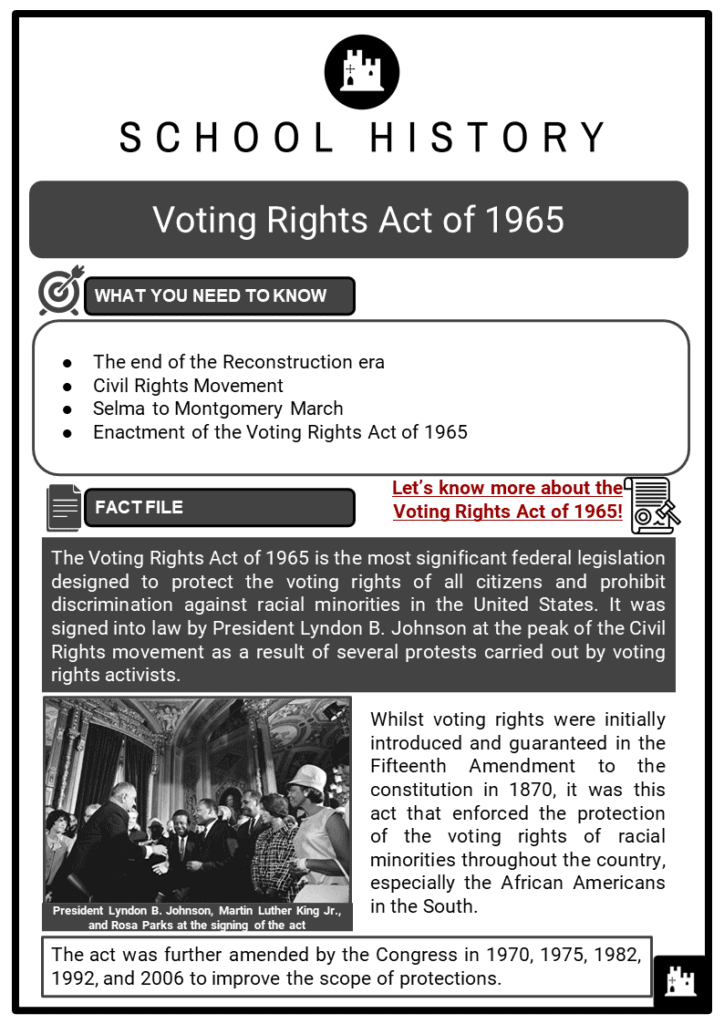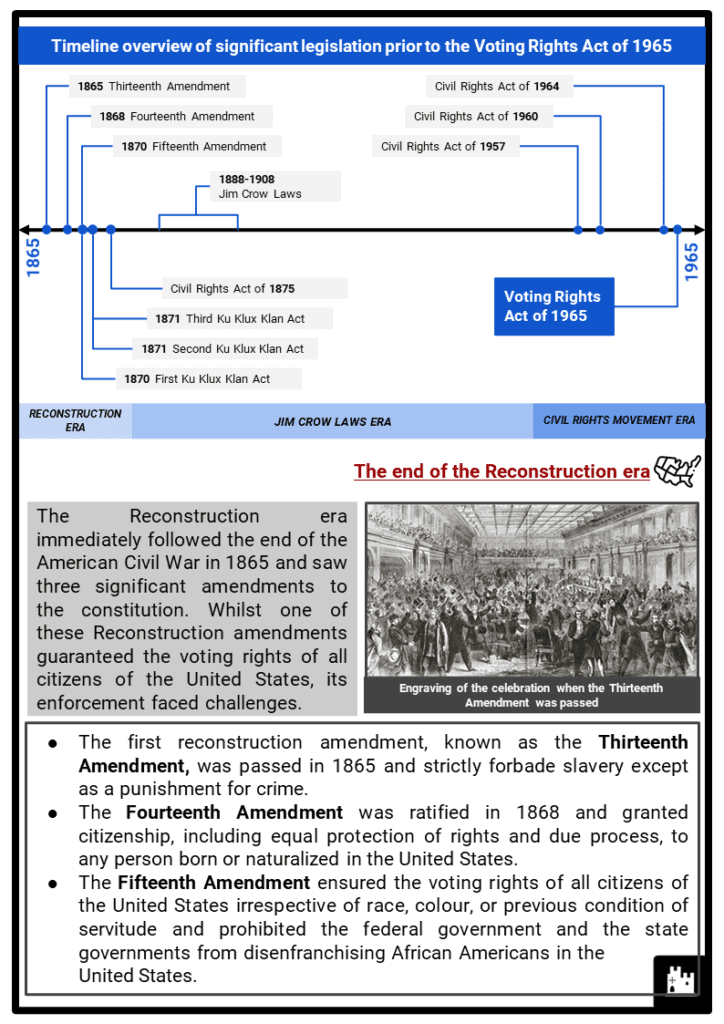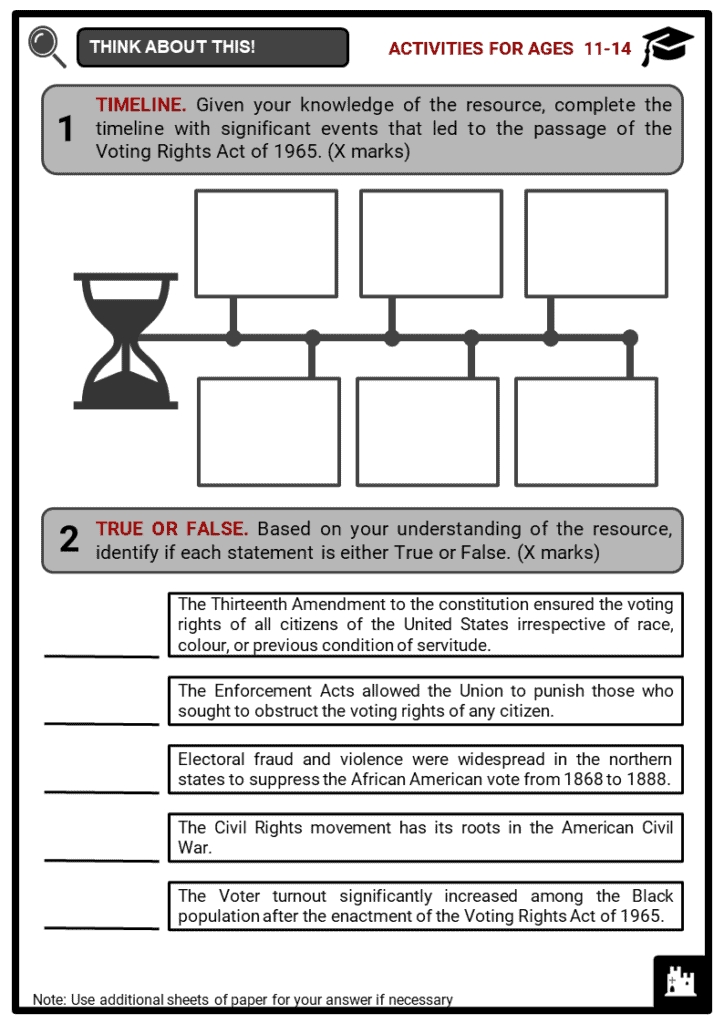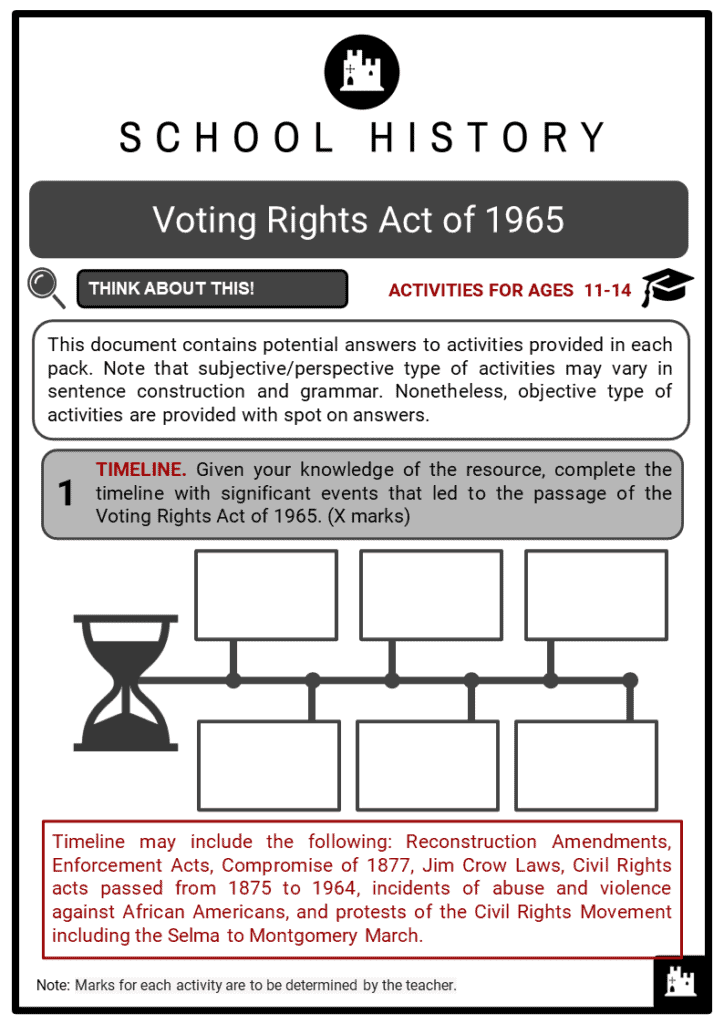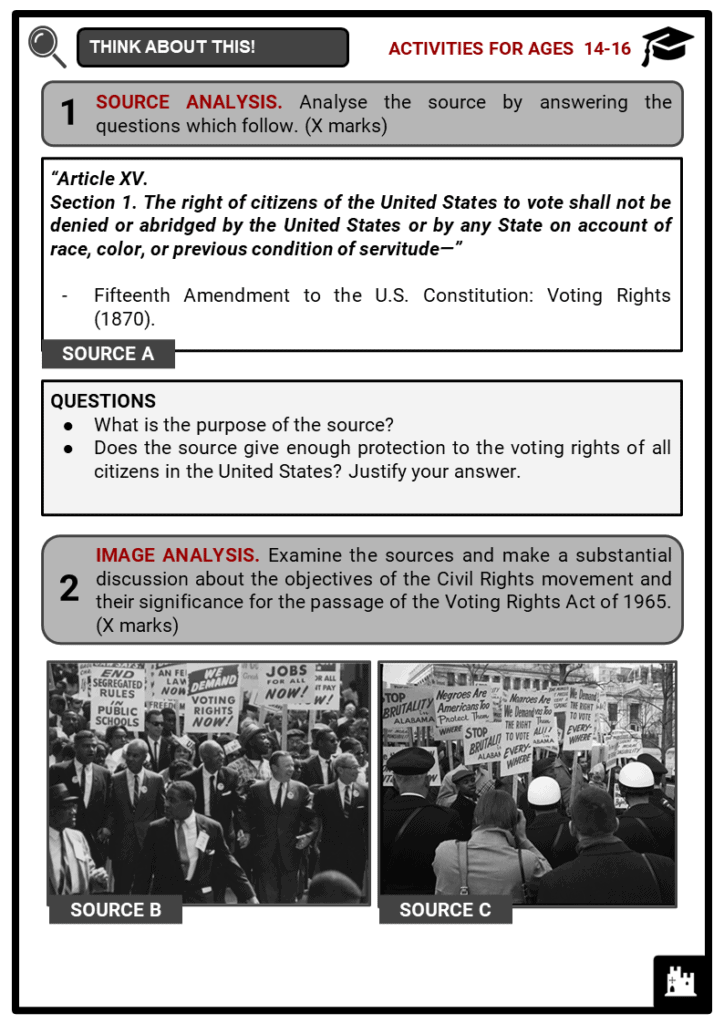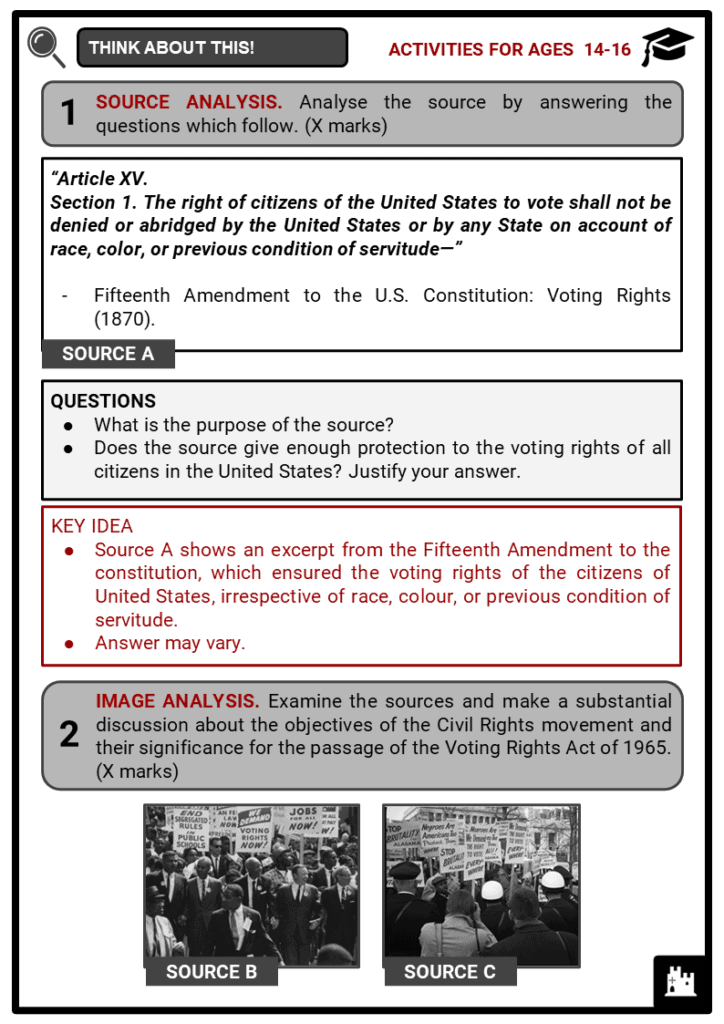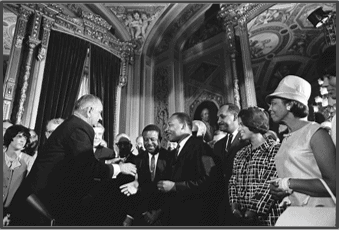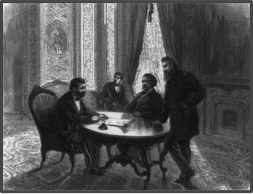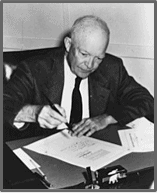Download Voting Rights Act of 1965 Worksheets
Do you want to save dozens of hours in time? Get your evenings and weekends back? Be able to teach Voting Rights Act of 1965 to your students?
Our worksheet bundle includes a fact file and printable worksheets and student activities. Perfect for both the classroom and homeschooling!
Table of Contents
Add a header to begin generating the table of contents
Summary
- The end of the Reconstruction era
- Civil Rights Movement
- Selma to Montgomery March
- Enactment of the Voting Rights Act of 1965
Key Facts And Information
Let’s know more about the Voting Rights Act of 1965!
- The Voting Rights Act of 1965 is the most significant federal legislation designed to protect the voting rights of all citizens and prohibit discrimination against racial minorities in the United States. It was signed into law by President Lyndon B. Johnson at the peak of the Civil Rights movement as a result of several protests carried out by voting rights activists.
- Whilst voting rights were initially introduced and guaranteed in the Fifteenth Amendment to the constitution in 1870, it was this act that enforced the protection of the voting rights of racial minorities throughout the country, especially the African Americans in the South.
- The act was further amended by the Congress in 1970, 1975, 1982, 1992, and 2006 to improve the scope of protections.
The end of the Reconstruction era
- The Reconstruction era immediately followed the end of the American Civil War in 1865 and saw three significant amendments to the constitution. Whilst one of these Reconstruction amendments guaranteed the voting rights of all citizens of the United States, its enforcement faced challenges.
- The first reconstruction amendment, known as the Thirteenth Amendment, was passed in 1865 and strictly forbade slavery except as a punishment for crime.
- The Fourteenth Amendment was ratified in 1868 and granted citizenship, including equal protection of rights and due process, to any person born or naturalized in the United States.
- The Fifteenth Amendment ensured the voting rights of all citizens of the United States irrespective of race, colour, or previous condition of servitude and prohibited the federal government and the state governments from disenfranchising African Americans in the United States.
- The Enforcement Acts were then introduced between 1870 and 1871 to ensure the effectiveness of the Reconstruction Amendments.
- These acts regulated the electoral process, including the voter registration process and allowed the Union to punish those who sought to obstruct the voting rights of any citizen.
- However, these laws became weak in the south and were further revoked by the Congress after the Compromise of 1877.
- As one of the terms of the Compromise of 1877, federal troops left the southern states after the uncontested election of President Rutherford Hayes.
- This effectively ended the Reconstruction era.
- In 1875, the Supreme Court challenged some aspects of the amendments and declared it unconstitutional.
- The southerners were opposed to the promotion of equality for the African American community since their economy had been dependent on slavery.
- Consequently, electoral fraud and violence were widespread in the region to suppress the African American vote from 1868 to 1888.
- The Jim Crow Laws were then introduced between 1888 and 1908 in the southern states in an effort to legalize the disenfranchisement of African Americans.
- These laws were a set of state and local laws that restricted the voting rights of Black people based on their ability to pay poll taxes, to own property, or to read and interpret documents.
- Additionally, African Americans needed to pass literacy tests and moral character tests, and prove that their grandfather had been eligible to vote.
- The Jim Crow Laws were arranged to segregate the black people from the white people and to restrict the movement of racial minorities.
- Segregation was introduced in public places, which separated “people of colour” from white people in public parks, public transportation, and school.
- As a result, African Americans were often subjected to violence and suffered from discrimination and various verbal and psychological attacks.
Civil Rights Movement
- The Civil Rights movement has its roots in the Reconstruction Era and had been actively fighting for the protection of voting rights for racial minorities. Several African Americans across the United States came together with other progressives to call for the end of racial discrimination, segregation, and disenfranchisement.
- The civil rights movement was generally carried out through nonviolent resistance and civil disobedience by the 1950s.
- A Supreme Court ruling in 1954 led to the collapse of the separate but equal policy, which had aided the Jim Crow Laws and had challenged the Fourteenth Amendment.
- A few other court rulings and nonviolent protests created critical situations and encouraged promising dialogues between the government and the civil rights activists between 1955 and 1968.
- Incidents of abuse and violence against the African Americans had upset the populace particularly the lynching of Emmett Till in Mississippi in 1955, which led to widespread support for the African American community in the United States.
- Protests such as the Montgomery Bus Boycott in 1955 were organised in Alabama.
- Sit-ins were also organised nationwide as a tactic to gain attention and response from the government, such as in North Carolina and Tennessee where a group of people occupied places in Greensboro and Nashville and refused to move until their demands were met.
- The Civil Rights Act of 1957 was signed on 9 September 1957 by President Dwight Eisenhower.
- This was the first time the Congress had passed civil rights legislation since the end of the Reconstruction era.
- The attorney general was given complete authority to file lawsuits on behalf of the victims of civil rights violations.
- The passage of the Civil Rights Act of 1960 further increased the scope of protection guaranteed to the minorities.
- The federal court was given the authority to oversee the voter registration process in the jurisdictions where discrimination was rampant.
- Whilst these acts aimed to uphold the rights of racial minorities, they were often obstructed by those who opposed them.
- Further efforts were made by Congress to enforce the civil rights laws in 1964.
- Equal administration of literacy tests was made compulsory for the registrars to reduce discrimination based on literacy.
- These acts still fell short of securing equal voting rights for the African American community, Latino community, Native American community, and other racial and linguistic communities in the United States.
- Several other large-scale marches were planned such as the 1963 Children’s Crusade in Birmingham and the 1965 Selma to Montgomery Marches in Alabama to further highlight the inequality faced by the African Americans.
Selma to Montgomery March
- On 7 March 1965, peaceful participants in a Selma to Montgomery march for voting rights were attacked by Alabama troopers with whips, tear gas and nightsticks. The march was a series of three protests along the 87-km highway from Selma, Alabama to Montgomery, the state capital.
- The march was a nonviolent protest regarding African American citizens' constitutional right to vote in Alabama and other southern states that had repressed African American suffrage.
- It was organised and participated in by various groups such as the Dallas County Voters League (DCVL), Student Nonviolent Coordinating Committee (SNCC), and Martin Luther King, Jr's Southern Christian Leadership Conference (SCLC).
- Even President Lyndon Johnson strategized with King to monitor the event and plan a bill about the issue.
- What was not anticipated was an attack by state troopers on 7 March 1965 with whips, tear gas and nightsticks.
- The assault came to be known as Bloody Sunday.
- One of the organisers, Amelia Boynton, was beaten unconscious and journalists published the offence.
- Another victim of the violence was a Unitarian Universalist minister from Boston, James Reeb.
- He was murdered at the second march on 9 March, known as Turnaround Tuesday, which was violently interrupted by Ku Klux Klan members.
- The violence that erupted at the march brought public outrage. On 15 March 1965, Johnson held a televised joint session of Congress asking for the passage of a voting rights bill which would benefit African Americans.
- On the third march on 21 March, Alabama governor George Wallace refused to protect the peaceful marchers.
- Johnson retaliated by protecting them with 1,900 members of the Alabama National Guard under federal command, federal marshals, and a number of FBI agents.
- On 24 March, the protesters reached Montgomery.
- The route they took has been designated as a U.S. National Historic Trail known as the 'Selma to Montgomery Voting Rights Trail'.
Enactment of the Voting Rights Act of 1965
- The Voting Rights Act of 1965 was introduced on 17 March and was passed into law on 6 August after several debates in the House of Representatives from May to July.
- The act was brought into effect by a vote of 333-85 and was signed by President Johnson in the presence of Martin Luther King, Jr, Rosa Parks, and several other civil rights leaders.
- The Voting Rights Act of 1965:
- Suspended the use of literacy tests and voter disqualification devices for five years.
- Authorised the use of federal examiners to supervise voter registration in states that used tests or in which less than half the voting-eligible residents registered or voted.
- Directed the U.S. Attorney General to institute proceedings against use of poll taxes.
- Provided criminal penalties for individuals who violated the act.
- What was the impact of the act?
- The Voter turnout significantly increased among the Black population after the enactment of the Voting Rights Act of 1965.
- In 1965, nearly 250,000 African Americans registered, one-third of whom were registered by federal examiners.
- In covered jurisdictions, 29.3% of the African American population was registered in 1965 and this further increased to 52.1% by 1967.
- A majority of African American residents was registered to vote in 9 of the 13 southern states.
- Similarly, the number of African Americans elected to office significantly increased.
- African Americans elected as state legislators in the eleven former Confederate states rose from 3 to 176 between 1965 and 1985.
- Major amendments to the act were enacted by the Congress in 1970, 1975, 1982, 1992, and 2006.
- Voting Rights Act Amendments of 1970
- Extended the provisions of the act for five years
- Made the act applicable to areas where less than 50% of the eligible voting age population was registered as of November 1968
- Voting Rights Act Amendments of 1975
- Extended the provisions of the act for seven years
- Established coverage for other minority groups including Native Americans, Hispanic Americans, and Asian Americans
- Permanently banned literacy tests
- Voting Rights Act Amendments of 1982
- Extended for 25 years the provisions of the act
- Allowed jurisdictions that could provide evidence of maintaining a clean voting rights record for at least 10 years, to avoid preclearance coverage
- Provided for aid and instruction to disabled or illiterate voters
- Provided for bilingual election materials in jurisdictions with large minority populations
- Voting Rights Language Assistance Act of 1992
- Extended the termination date on the prohibition of covered States and political subdivisions providing voting materials only in English
- Modified criteria for determining whether a State or subdivision is covered
- Voting Rights Act Reauthorization And Amendments Act of 2006
- Extended the provisions of the act for 25 years
- Extended the bilingual election requirements through to 5 August 2032
- Directed the U.S. Comptroller General to study and report to Congress on the implementation, effectiveness, and efficiency of bilingual voting materials requirements
Image sources:
- https://upload.wikimedia.org/wikipedia/commons/thumb/6/64/Lyndon_Johnson_and_Martin_Luther_King%2C_Jr._-_Voting_Rights_Act.jpg/1024px-Lyndon_Johnson_and_Martin_Luther_King%2C_Jr._-_Voting_Rights_Act.jpg
- https://upload.wikimedia.org/wikipedia/commons/thumb/d/df/Washington%2C_D.C._-_President_Grant_signing_the_Ku-Klux_Force_Bill_in_the_President%27s_room_with_Secretary_Robeson_and_Gen._Porter%2C_at_the_Capitol%2C_April_20_LCCN2002716005.tif/lossy-page1-775px-thumbnail.tif.jpg
- https://upload.wikimedia.org/wikipedia/commons/thumb/b/ba/Photograph_of_President_Dwight_D._Eisenhower_Signing_the_Civil_Rights_Act_of_1957_%28H.R._6127%29_in_His_Office_at_the_Naval_Base_in_Newport%2C_Rhode_Island_-_NARA_-_7865612.jpg/220px-thumbnail.jpg

